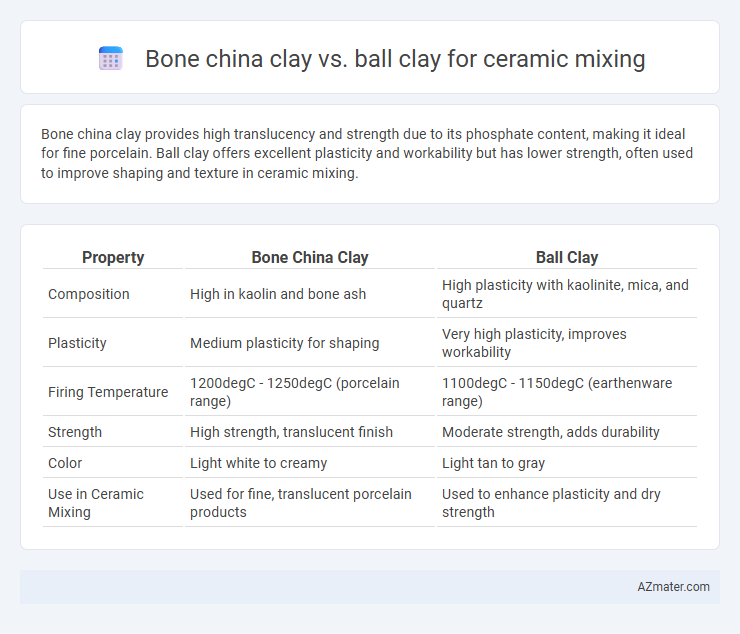Bone china clay provides high translucency and strength due to its phosphate content, making it ideal for fine porcelain. Ball clay offers excellent plasticity and workability but has lower strength, often used to improve shaping and texture in ceramic mixing.
Table of Comparison
| Property | Bone China Clay | Ball Clay |
|---|---|---|
| Composition | High in kaolin and bone ash | High plasticity with kaolinite, mica, and quartz |
| Plasticity | Medium plasticity for shaping | Very high plasticity, improves workability |
| Firing Temperature | 1200degC - 1250degC (porcelain range) | 1100degC - 1150degC (earthenware range) |
| Strength | High strength, translucent finish | Moderate strength, adds durability |
| Color | Light white to creamy | Light tan to gray |
| Use in Ceramic Mixing | Used for fine, translucent porcelain products | Used to enhance plasticity and dry strength |
Introduction to Ceramic Clays: Bone China Clay vs Ball Clay
Bone china clay offers high whiteness, translucency, and strength due to its significant bone ash content, making it ideal for fine ceramics. Ball clay is prized for its plasticity, fine particle size, and strong bonding properties, enhancing workability and durability in ceramic mixing. Combining bone china clay with ball clay balances aesthetic qualities and structural integrity in ceramic production.
Composition Differences: Bone China Clay and Ball Clay
Bone china clay contains a high proportion of bone ash, typically around 40-50%, combined with kaolin and feldspar, which gives it translucency and whiteness in ceramics. Ball clay is primarily composed of kaolinite, mica, and quartz, with a high plasticity that improves the shaping and workability of ceramic mixtures. The key composition difference lies in bone china's bone ash content versus ball clay's higher organic matter and finer particle size, influencing the final ceramic body's strength and texture.
Physical Properties Comparison: Bone China Clay vs Ball Clay
Bone china clay exhibits higher whiteness and translucency due to its calcium phosphate content, contributing to its delicate appearance and strength, while ball clay is valued for its plasticity and fine particle size, enhancing moldability. The plasticity index of ball clay ranges from 25 to 45%, making it highly workable, whereas bone china clay has lower plasticity but provides greater fired strength and chip resistance. Ball clay typically has lower firing temperature requirements around 1100-1200degC, compared to bone china clay that vitrifies at higher temperatures near 1250-1280degC, affecting the final ceramic body's density and porosity.
Workability in Ceramic Mixing
Bone china clay offers excellent plasticity and smooth workability, making it ideal for delicate ceramic mixing and fine detailing. Ball clay provides high plasticity and strong binding properties, enhancing the mixture's strength and shaping capabilities. Combining bone china and ball clay balances softness and firmness, optimizing the ceramic mixture's workability and durability.
Firing Temperature and Color Outcomes
Bone china clay typically requires a higher firing temperature, usually around 1200-1250degC, resulting in a translucent, white, and delicate finish ideal for fine ceramics. Ball clay fires at a lower temperature, approximately 1100-1150degC, producing a denser and more plastic body that often yields off-white to beige tones. Mixing bone china clay with ball clay balances workability and firing temperature, optimizing the final ceramic color and strength.
Strength and Durability: Which Clay Performs Better?
Bone china clay offers superior strength and durability due to its high calcium phosphate content, which enhances vitrification and creates a denser, more resilient ceramic body. Ball clay, while highly plastic and flexible for shaping, contains a higher proportion of impurities and organic matter, resulting in lower fired strength and increased porosity compared to bone china clay. For ceramic mixing aimed at maximizing mechanical strength and durability, bone china clay performs better, especially in fine dinnerware and delicate porcelain applications.
Suitability for Different Ceramic Applications
Bone china clay offers high translucency and whiteness, making it ideal for fine tableware and decorative ceramics requiring delicate finishes. Ball clay provides excellent plasticity and binding properties, enhancing workability in functional ceramics such as tiles and sanitary ware. Selecting between bone china and ball clay depends on whether the application prioritizes aesthetic precision or structural strength in ceramic production.
Impact on Glaze and Surface Finish
Bone china clay imparts a smooth, translucent quality to ceramics, enhancing glaze adhesion and producing a glossy, refined surface finish due to its high kaolin content and low impurities. Ball clay contributes plasticity and strength, allowing for better shaping and reducing glaze defects such as crazing or pinholing by improving the clay body's uniformity. Combining both in ceramic mixing balances workability with optimal glaze performance, resulting in durable, aesthetically pleasing finishes.
Cost and Availability of Bone China Clay and Ball Clay
Bone china clay, also known as kaolin, typically commands a higher price due to its purity and whiteness, making it essential for high-quality ceramics, but it tends to be less abundant and sourced mainly from limited deposits. Ball clay is significantly more affordable and widely available, offering excellent plasticity and plastic strengthening properties, which makes it a cost-effective choice for ceramic mixing. Manufacturers often balance the high cost and limited supply of bone china clay with the abundant and economical ball clay to optimize production efficiency and final product quality.
Choosing the Right Clay: Recommendations for Ceramic Artists
Bone china clay provides high whiteness, translucency, and strength, ideal for fine porcelain and detailed ceramic work, whereas ball clay offers excellent plasticity and binding properties, making it essential for shaping and forming durable ceramic bodies. Ceramic artists seeking smooth, delicate finishes often prefer bone china clay, while those requiring increased workability and flexibility in their mixtures rely on ball clay. For optimal ceramic mixing, combining bone china clay's refined quality with ball clay's moldability enhances both aesthetic appeal and structural integrity.

Infographic: Bone china clay vs Ball clay for Ceramic mixing
 azmater.com
azmater.com